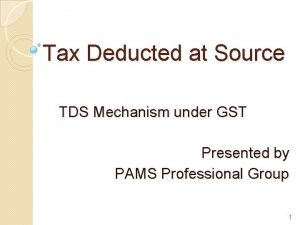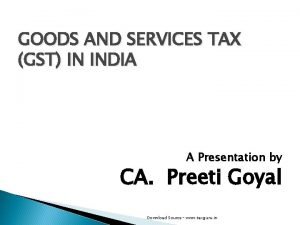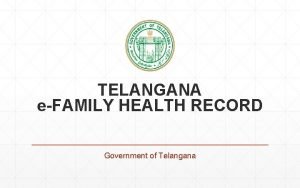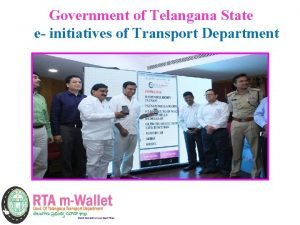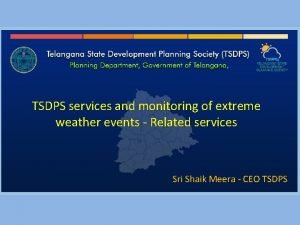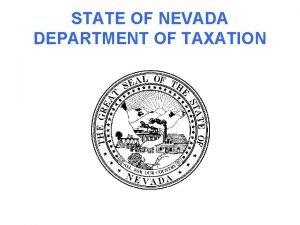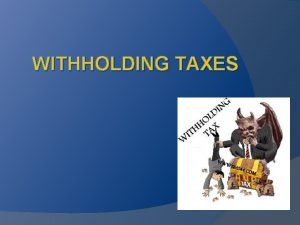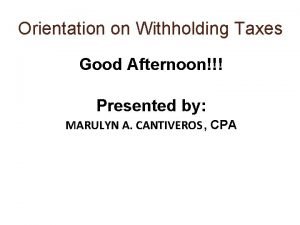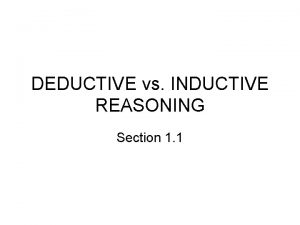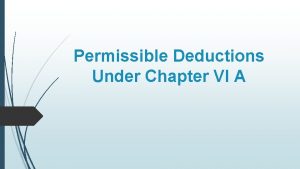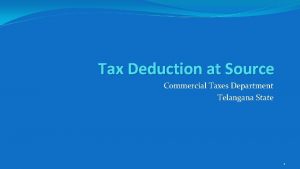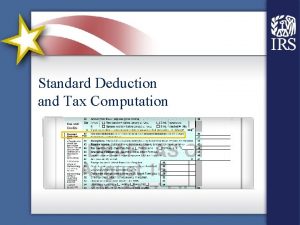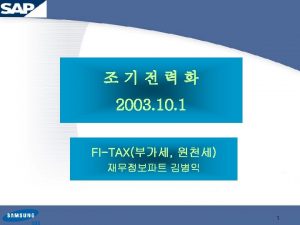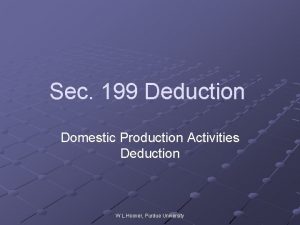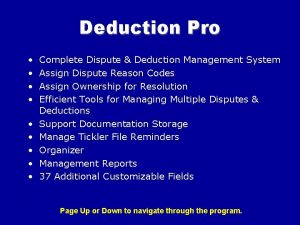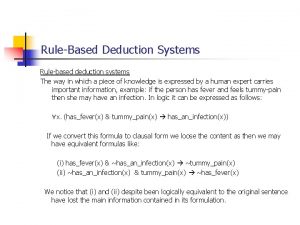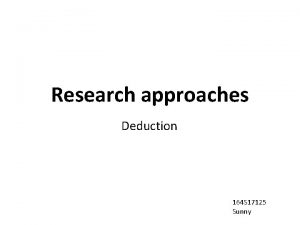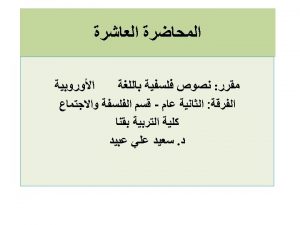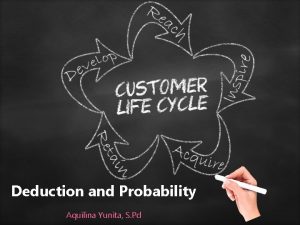Tax Deduction at Source Commercial Taxes Department Telangana



















- Slides: 19

Tax Deduction at Source Commercial Taxes Department Telangana State 1

Introduction • Goods and Services Tax is an indirect tax levied on the supply of goods and/or services. It is a destination based tax. The GST would apply to all goods other than alcoholic liquor for human consumption and five Petroleum products. • GST Act replaced Central Acts such as Central Excise duty, Service Tax, Central Surcharges etc. and State Acts such as VAT Act, CST Act, Luxury Tax, Entertainment Tax, Entry Tax etc. 2

Some Key words: Taxable Supply: means the supply of goods or services or both which is leviable to tax under GST Act. Deductor: Deductor is the person who is required to deduct TDS for a supply from a supplier. Deductee: The supplier from whom tax is deducted. 3

Legal provision • Tax deduction at Source by the notified category of persons is mandatory as per Section 51 of the CGST and TGST Acts, 2017. • Registration as a Tax Deductor is to be taken separately even if the person / undertaking etc. is having GSTIN for business purposes. 4

The following persons need to deduct TDS 1. A department or establishment of the Central or State Government, or 2. Local authority, or 3. Governmental agencies, or 4. An authority or a board or any other body which has been set up by Parliament or a State Legislature or by a government, with 51% equity (control) owned by the government. 5. A society established by the Central or any State Government or a Local Authority and the society is registered under the Societies Registration Act, 1860. 6. Public sector undertakings. 5

Value of supply on which TDS shall be deducted For the purpose of deduction of TDS, the value of purchases or contract is to be taken as the amount excluding the tax indicated in the invoice. This means TDS shall not be deducted on the CGST, SGST or IGST component of invoice . whom would you pay TDS To TDS shall be paid within 10 days from the end of the month in which tax is deducted. The payment shall be made to the appropriate government, which means: CENTRAL GOVERNMENT STATE GOVERNMENT - In case of IGST & CGST In case of SGST 6

Rate of TDS • TDS is to be deducted at the rate of 1% under Telangana GST and 1% under Central GST or 2% IGST from the payments made to the supplier of taxable goods and/or services, where the total value of such supply, exceeds two lakh fifty thousand rupees under a contract. 7

Illustration (a) For instance gross taxable contract value is Rs 2, 70, 000/ Supply value before tax is Rs 241071/ SGST and CGST collection @ 12% - Rs 28929/ Total – Rs 270000/-, in this case TDS is not applicable as net value of contract is less than Rs 250000/-. (b) For instance gross taxable contract value is Rs 3, 10, 000/ Net Rs 276786/ SGST and CGST collection @ 12% - Rs 33214/ Total – Rs 310000 /-, in this case TDS will be @ 1% each under SGST and CGST is applicable as net value of contract is more than Rs 250000/-. 8

Intra-State supply Generally, when both the supplier and the recipient are within the State, the supply is “Intra State Supply” (within the State Supply). In such case, TDS of 1% CGST and 1% SGST shall be made. Inter-State supply Generally, when the supplier is in a State other than the State of the receiver (i. e. the supply is from outside the State), the supply is Ïnter State supply”and TDS of 2% IGST shall be made. 9

Filing of Return and issue of TDS certificate 1. TDS deducted should be reported in a return form GSTR 7 by the 10 th day of the month succeeding the month in which TDS was collected. Eg. If TDS is made in the month of October, 2018, the Return in GSTR 7 shall be filed before 10 th November, 2018. 2. If in any month there is no deduction on account of TDS, no need of file return for that month. 3. They need to issue a certificate in form GSTR-7 A to the supplier within 5 days of filing of return in Form GSTR – 7 mentioning therein the contract value, rate of deduction, amount deducted, the amount paid to the appropriate Government. GSTR-7 A is generated online by the system. 10

When TDS not applicable a) Total value of taxable supply ≤ Rs. 2. 5 Lakh under a contract. b) Contract value > Rs. 2. 5 Lakh for both taxable supply and exempted supply, but the value of taxable supply under the said contract ≤ Rs. 2. 5 Lakh. c) Receipt of services which are exempted. For example services exempted under notification No. 12/2017 – Central Tax (Rate) dated 28. 06. 2017 as amended from time to time. d) Receipt of goods which are exempted. For example goods exempted under notification No. 2/2017 – Central Tax (Rate) dated 28. 06. 2017 as amended from time to time. 11

When TDS not applicable …. e) Goods on which GST is not leviable. For example petrol, diesel, petroleum crude, natural gas, aviation turbine fuel (ATF) and alcohol for human consumption. f) Where a supplier had issued an invoice for any sale of goods in respect of which tax was required to be deducted at source under the VAT Law before 01. 07. 2017, but where payment for such sale is made on or after 01. 07. 2017. g) Where the location of the supplier and place of supply is in a State which is different from the State where the deductor is registered. Where the tax is to be paid on reverse charge by the recipient i. e. the deductee. 12

How can the Deductee claim the benefit of TDS? Any amount deducted as TDS and reported in GSTR – 7 will automatically reflect in electronic cash ledger of the Deductee. 13

Refund of the excess amount deducted In case the amount is claimed by the deductee in his electronic cash ledger Refund to deductor is not possible in such case. However, deductee can claim a refund of tax subject to refund provisions of the act. In case the amount is not so claimed by the dealer Refund of erroneous excess TDS deducted is possible (to deductor) , subject to refund provision and procedure of the act. (This condition arises when deductor not filed return GSTR-7) 14

Requirements for registration 1. 2. 3. 4. Applicant must have a valid PAN or a TAN. Valid mobile number. Valid E-mail ID. Applicant must have the following documents and information on all mandatory fields as required for registration. (a) Passport size photo (<100 KB in JPEG format) (b) PAN card (c) Address proof for Own premises: Latest Property Tax receipt or Electricity bill for Rented or Leased premises: Valid Rent / Lease agreement along with ownership proof like property tax receipt or electricity bill for premises not covered above: A consent letter with any document in support of the ownership like property tax or electricity bill (d) DSC of DDO/ Aadhar verification / EVC (e) If authorized signatory is other than DDO then passport size photo of such person. 15

Payments Payment Modes Introduction GST Payment Modes Online Payments Credit/Debit card Other Payment Methods Internet Banking Over the Counter NEFT/RTGS NOTE: All payments are deposited into the Electronic Cash Ledger & funds are utilized from it when taxpayer makes payments for liabilities. Slide 16

Penal Provisions § Registration: Section 25(1): Every person who is liable to be registered under Section 22 (regular registration) or Section 24 (TDS etc) shall apply for registration within thirty days from the date on which he becomes liable to registration. § Failure to take Registration Section 122(1) (xi) – Offences & Penalties: Where a taxable person who is liable to be registered under this Act but fails to obtain registration – shall be liable to pay a penalty of ten thusand rupees or an amount equivalent to the tax evaded or the tax not deducted under Section 51 or short deducted or deducted but not paid to the Government. . Or input tax credit availed of or passed on or distributed irregularly, or the refund claimed fraudulently, whichever is higher. 17

Penal Provisions Failure to furnish the certificate in form GSTR-7 A to the deductee by the deductor after deducting the tax at source, within five days of crediting the amount so deducted to the Government: The deductor shall pay, by way of a late fee, a sum of one hundred rupees per day from the day after the expiry of such five day period until the failure is rectified, subject to a maximum amount of five thousand rupees. ---- Section 51(4) Failure to pay to the Government the amount deducted: The deductor shall pay interest at a rate not exceeding eighteen percent in addition to the amount of tax deducted. ----- Section 51(6) Failure to deduct the tax or deducts an amount which is less than the amount required to be deducted or failure to pay to the Government , the amount deducted as tax: Liable to pay a penalty of ten thousand rupees or an amount equivalent to the tax evaded or the tax not deducted or deducted but not paid to the Government, whichever is higher. ----- Section 122(1) 18

U O Y K N A TH 19
 Planning department telangana
Planning department telangana Gst deduction at source
Gst deduction at source Gst deduction at source
Gst deduction at source Commercial and non commercial food service
Commercial and non commercial food service Ralphs annual income is about $32 000
Ralphs annual income is about $32 000 Gst conclusion
Gst conclusion Environmental issues in telangana
Environmental issues in telangana Auditonline.gov.in/demo/
Auditonline.gov.in/demo/ Ncd jhs telangana gov in
Ncd jhs telangana gov in Rta transport telangana
Rta transport telangana Hmda land use information
Hmda land use information Tsdps
Tsdps Nevada department of taxation modified business tax return
Nevada department of taxation modified business tax return Hypdro
Hypdro Commercial source of energy
Commercial source of energy Certificate of creditable tax withheld at source 2307 form
Certificate of creditable tax withheld at source 2307 form 2306 bir form
2306 bir form Deductive reasoning examples
Deductive reasoning examples Permissible deductions
Permissible deductions Deduction practice pictures
Deduction practice pictures


